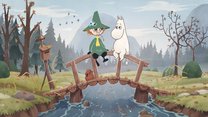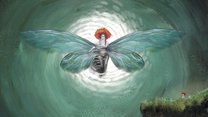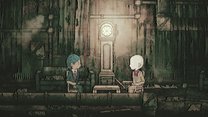The Night Is Grey review

- 0 Comments
Beautiful cinematic side-scroller provides plenty of challenge and biting psychological thrills
The “grown man meets little girl and vows to protect her” theme is part of what made games like The Walking Dead and The Last of Us so great, as it’s highly effective at stirring up powerful emotions. And that’s exactly what Whalestork Interactive does with The Night Is Grey, their very first point-and-click brainchild. This side-scrolling cinematic thriller brings two contrasting characters together and takes you on a creepy ride through dark forests and abandoned mines, where you’ll thoroughly (if tensely) enjoy puzzling your way past all kinds of physical obstacles to bring your young charge to her grandparents’ house while keeping her safe from a band of roving wolves.
Graham is in danger himself as he runs through the forest away from a wolf pack before stumbling upon a cabin. The lights are out, but smoke rises from its chimney. Inside, a little girl, Hannah, emerges from the glow of a fire in the darkness and points a rifle at him.
Thus starts The Night Is Grey, and immediately the visually stunning graphic style is apparent. The digitally painted and fully animated panoramic backgrounds come beautifully together in separate layers. They move independently from each other, the parallax scrolling creating a great effect of depth, as if you’re walking past an elaborate three-dimensional diorama. Although hand-drawn, the environment appears very realistic, dark and somber, in contrast to the more colorful and cartoony style of the characters.
Graham and Hannah aren’t voiced but they do make the occasional sounds. Hannah is prone to giggling; Graham will sigh. Hannah will try to whistle; Graham has to cough. It’s great to have at least these little vocal utterances to make them feel more real. There are also environmental sound effects – footsteps crunching on the forest floor, rustling of leaves, crackling fire, a buzzing electric fence, and lots more – and an original orchestral soundtrack featuring dozens of instruments, with different tracks for each general area of the game. Together the soundscape helps make the game feel like a complete cinematic experience.

Do I miss voice-overs in this day and age? Yes, but more because we’ve become accustomed to them. When I read Graham’s dialogue in my head, in particular, I imagined him sounding like actor Robert Patrick in his role of The Dig’s Boston Low. Even without hearing them out loud, however, his lines are excellently written. He’ll often make dad jokes, and after he has found Hannah’s stuffed toy Storky – a reference to Whalestork’s own logo – he’ll often whip it out and have a funny discussion with it, ventriloquist style, commenting on their circumstances, unafraid to poke fun at himself. Hannah’s lines can be surprising too. She’s just a little girl but will often say something profound or poetic (referring to her mother in saying, “She has dark stars in her face…”) or simplify Graham’s problems in a way that’s more relatable, like when Graham talks about his aquaphobia. As a nice touch, to make up for the lack of actual volume, the screen will shake each time one of them screams, anime-style.
The only real issue I have with the presentation is the way the dialogue text is handled. You have to click each line away before getting the next one, and there’s no option to put it on auto-advance. In itself this is no big deal, but the sentences themselves are cut up into smaller sections, as if a dialog “box” can only contain a limited number of characters. Continually causing these unnecessary pauses really hurts the flow of the story. The lines also appear typewriter-style, letter by letter, word by word. You can click to have the entire line appear immediately, but the game’s responses in that regard can be a bit finicky sometimes. I encountered a couple other text glitches as well. Very rarely, a black shadow appears as if the letters were displaying twice on top of each other. And when the game zooms in or out, words at the end of the top line can suddenly jump to the bottom one and back.
Fortunately Hannah doesn’t shoot Graham, or this would have been an awfully quick adventure. Instead, the first puzzles thrown your way involve getting the cabin’s electricity to run again and win Hannah’s trust. While many side-scrolling games use keyboard controls, here you move Graham in standard point-and-click fashion. The cursor is a small white dot that changes into an arrow to indicate scene exits; a right-click allows for fast travel. Hover over a hotspot and the dot grows in size with a white circle around it. You can also reveal all hotspots with a tap of the spacebar if you’re not sure you’ve found everything there is to find in a particular scene, but most relevant objects are clearly discernible so you won’t have to resort to pixel hunting.

Right-clicking hotspots causes Graham to describe what he sees. You can try picking up items with a left-click, but if you cannot do so, Graham will provide additional comments on them. Sometimes hotspots can be further manipulated, which usually means searching them for usable items, often going in for a closer look when it involves books or notes - which can hold useful information like numbers used in codes - or machines or other devices – like a fuse box, a drainage system with valves, or a security card scanner. The inventory is of the pop-up variety when you hover the cursor at the top of the screen.
Sometimes manipulating an object will produce a small minigame, such as when you have to start up a generator. In this case, you have to click exactly when a moving indicator reaches the sweet spot on a line to pull the generator cord and fire up the engine. You’ll face a couple of these throughout the game, always a bit different in shape and style, but all they need is a couple of well-timed clicks. It’s a different form of gameplay that adds to the already great variety of obstacles you face.
Eventually Graham and Hannah are forced to leave the cabin behind. The major goal in the game from that point on is to get Hannah to her grandparents’ house, and after that to try to locate her mother. This takes the pair from the forest to a mining camp, through the mine tunnels and up to the safe high ground of a watchtower for a short stay.
Puzzles along the way vary between basic inventory challenges and logical brainteasers. For the security card scanner blocking the entrance to the mining camp office, you first need to find a working card, but you also require the correct number combination linked to that card, which then must be translated into a color code. The information is all there, but there’s no hand-holding to guide you through this or any of the other puzzles, so it might be a good idea to jot down important information you find in a notebook.

The Night Is Grey autosaves when you reach checkpoints in the story, but also allows your own manual saves. Both of which are useful because you can die in this game! I wasn’t expecting this, and up until the first time it happened, I was fine relying on the autosave. The game’s six chapters are linear after all, each one leading you to a new area with no possibility to return to previous locations. While there’s often a feeling of dread, with wolf silhouettes regularly moving in the back- or foreground, hiding in the shrubbery, I didn’t think you could do anything truly dangerous, or fall victim to fatal incidents. Well, I should have guessed again. During one playing session alone, I was slammed in the face with at least seven game-over screens.
There’s one dark area you need to explore using an oil lamp, but the oil runs out. You encounter regular refills along the way, but take a wrong turn and you might just spend one screen too many using the lamp, and it’ll extinguish, causing you to stumble in the dark and fall to your doom. The last checkpoint was right when you started navigating the tunnels, so without manual saving along the way, you’ll have to begin again from scratch. There’s a handy map to navigate this area, but it doesn’t show those oil refills. So while you might have to go one way according to the map, it might be wiser to go the other way first, fill up your lamp again, and continue your journey from that point on. This section was inches shy of becoming frustrating. It’s reminiscent of the mazes in early adventure games, but I’m more forgiving here since you do have that map, and progressing through the area is otherwise pretty straightforward.
I was also pleasantly surprised to see a dialogue puzzle. At one point you face an adversary (whose identity I won’t divulge) who provides you with several philosophical questions about how Graham would react in certain situations, and each time you have to choose from three possible replies. Give a wrong answer, and the adversary will approach slowly. Fail too often and they’ll be close enough to kill you. Give enough correct replies and the story will progress. I wasn’t expecting this kind of gameplay and finding the correct reply can be tricky, so I died here several times as well. All options are viable, so you have to psychologically read the situation and try to deduce the answer you think the adversary wants you to give. Despite sometimes failing at first (the questions remain the same if forced to start again), it was always interesting to read the adversary’s arguments in this mind game being played with Graham.
Gradually you’ll come to learn more about these two very different protagonists on their perilous journey, although more is revealed about Hannah’s background and family than Graham’s. You don’t ever really find out where he comes from. He often reminisces about his past, his youth, his father who used to work in a mine; little clues about his identity keep trickling in. Written quotes appear during chapter interludes, offered by an unknown person, most likely a parent addressing their child. These dark quotes are examples of verbal abuse, and seem to foreshadow events that have yet to come, or already have come to pass.
I should also warn you there is some disturbing imagery in The Night Is Grey, straight out of a David Cronenberg movie. This might be expected in a story with people being chased by wolves, but still, you won’t see this one coming! Indeed, this game isn’t only about the physical threats inhabiting the world we live in, but also the psychological dangers that can really warp one’s mind. Spoilers prevent me from further divulging, but The Night Is Grey does take some unexpected turns where you’ll start to question everything that has happened before.
Final Verdict
During my eight hours of gameplay, The Night Is Grey constantly kept me on my toes. It challenged me with some doozy logic puzzles I was able to solve just before frustration set in, but thankfully its more straightforward inventory puzzles were able to balance the difficulty. The gorgeous scenery and frame-by-frame animation blew me away, and the chemistry between man and child, so well presented through their dialogue, made me forget they weren’t even voiced. There’s tension throughout the journey, and the quest to keep Hannah safe really makes you feel responsible, motivating you to hurry up and find your way out of danger. And then there are the story twists, the constant hinting at Graham’s past, the strange occurrences with the wolves, and a memorable ending that is sure to make you do a double take. Overall, it’s a wonderful journey that combines all of the elements that I enjoy most, and I consider it a must-play for other fans of traditional adventure games.
Hot take
With its beautiful scenery, heartfelt characters, and the weirdest wolves you’ve ever seen, The Night Is Grey is as close to a psychological thriller as an adventure game can get, worthy to be called an interactive cinematic experience.
Pros
- Gorgeously hand-animated diorama-style environments
- Funny and endearing dialogue provides great chemistry between the two lead characters
- Balanced combination of difficulty and gameplay elements
- Exciting storyline with unexpected twists that will make you question your sanity
Cons
- Full voice-overs would have personalized the characters even more
- Dialogue text can be glitchy
Johnny played The Night Is Grey on PC using a review code provided by the game’s publisher.

- Advertisement
- Help support AGH by advertising with us










0 Comments
Want to join the discussion? Leave a comment as guest, sign in or register.
Leave a comment